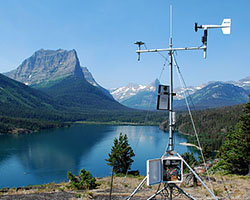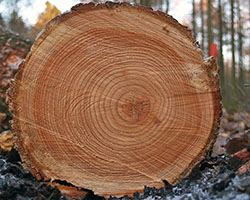
When you walk outside in the morning, you can probably tell what the weather will be like for the next few hours. And you can probably remember what the weather was like yesterday and maybe even last week. However, long-term climate is a bit harder to measure and requires special tools.
Scientists who study climate use many different instruments to collect data. Today, weather stations all over the world record air temperatures and amount of rain or snow that falls. Looking at these data across many years shows how climate has changed. Satellites in outer space that orbit Earth, are also used to study climate. On board these satellites are special sensors which can take pictures of the Earth’s surface and measure temperatures. Data collected from these instruments allow scientists to measure indicators of climate change, like how much sea ice is in the arctic and the temperature of the entire ocean.
Looking Into the Past
To study climate from the past, long before humans started to keep track of it, scientists measure something that is related to climate but not climate itself. The things they measure are called climate proxies.

One example of a climate proxy is tree rings. The number and shape of a tree's growth rings depends on the climate in which it grew. By looking at the rings, scientists can get an idea of what the climate was like when the tree was growing.
Other climate proxies are air bubbles and chemicals trapped in the sediment at the bottom of the ocean or lakes, or trapped inside glaciers. When things settle at the bottom of the ocean or a lake or when snow falls on top of a glacier, little pockets of air and chemicals become trapped. Scientists use equipment to drill down into the ice or sediment and take samples called cores. The deeper they drill the further back in time they can get. The chemicals inside the ice cores and sediment cores help scientists learn what the climate was like millions of years ago.
Visit our links page to find more resources on climate change. Ice core image by Laurent Augustin.
Read more about: Crazy Climate and Wacky Weather
Bibliographic details:
- Article: Climate Study Toolbox
- Author(s): Dr. Biology
- Publisher: Arizona State University School of Life Sciences Ask A Biologist
- Site name: ASU - Ask A Biologist
- Date published: 2 Feb, 2016
- Date accessed:
- Link: https://askabiologist.asu.edu/climate-study-toolbox
APA Style
Dr. Biology. (Tue, 02/02/2016 - 16:30). Climate Study Toolbox. ASU - Ask A Biologist. Retrieved from https://askabiologist.asu.edu/climate-study-toolbox
Chicago Manual of Style
Dr. Biology. "Climate Study Toolbox". ASU - Ask A Biologist. 02 Feb 2016. https://askabiologist.asu.edu/climate-study-toolbox
Dr. Biology. "Climate Study Toolbox". ASU - Ask A Biologist. 02 Feb 2016. ASU - Ask A Biologist, Web. https://askabiologist.asu.edu/climate-study-toolbox
MLA 2017 Style

Ice cores, like the one that was just drilled here, or sediment cores, give scientists a look at the chemicals that were present in the air millions of years ago.
Be Part of
Ask A Biologist
By volunteering, or simply sending us feedback on the site. Scientists, teachers, writers, illustrators, and translators are all important to the program. If you are interested in helping with the website we have a Volunteers page to get the process started.

